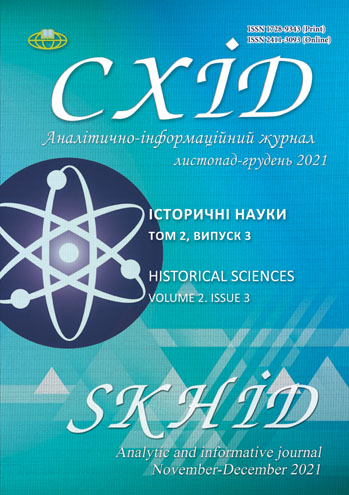The image of the enemy in textbooks on the history of the USSR in the 1930s
on the example of "A Short Course on the History of the USSR" by A. Shestakov
DOI:
https://doi.org/10.21847/1728-9343.2021.2(3).244789Keywords:
image of the enemy, textbook on the history of the USSR, Bolshevik propaganda, educationAbstract
The article examines the peculiarities of the formation of the image of the enemy in the textbook of Andrei Shestakov "A Short Course in the History of the USSR." Also, the historiography of the issue is analyzed. It applies to both the Soviet era and the present. Despite the modest attention to this topic by foreign experts, the works that directly affect the issue are highlighted. The main changes in the then system of school education, which led to its unification and formed the requirements for the history lesson in general and the need to develop a textbook in particular, are outlined. The role of Andrei Shestakov, who was one of the first to develop an "ideal" history textbook for the Soviet government, is revealed. His career growth and work with Marxist-Leninist ideology are shown, which in turn helped to achieve this goal.
The process of modification of negative connotations concerning those forces against which the Bolsheviks fought is traced. Thus considering the period of ancient history, the author criticized rich people. The negative image deepened when it came to religion in the Middle Ages. Priests and monks, compared to the wealthy, were perceived not as something "foreign" but more negative as something "hostile." Wealthy peasants received a special color, the term "kulaks" was used for them. The closer A. Shestakov approached the twentieth century in his presentation of historical material, the clearer the formation of the image of the enemy, not only internal but also external. Thus, the first was personified by all the forces against which the Bolsheviks fought. To define such "enemies" used the definition - "counter-revolutionary". The second category was represented by the Entente and the Nazis, who came to power primarily in Germany and Italy.
Downloads
References
Borysov, V. (2003). Stanovlennia ta rozvytok zahalnoosvitnoi shkoly v Ukraini 1920–1933 rr. dys. ... kandydata ist. nauk: 07.00.01. Dnipropetrovsk. (In Ukrainian)
Bukhalo, S. (2001). Osvita na Radianskii Ukraini. Kyiv. (In Ukrainian)
Diatlova, O. (2008). Intehratyvnyi pidkhid do navchannia suspilstvoznavstva v zahalnoosvitnikh shkolakh Ukrainy (20-ti – 30-ti rr. KhKh stolittia) dys. ... kand. ped. Nauk. Luhanskyi natsionalnyi un-t im. Tarasa Shevchenka. Kyiv. (In Ukrainian)
Ewing, T. (2004). A Stalinist Celebrity Teacher: Gender, Professional, and Political Identities in Soviet Culture of the 1930s. Journal of Women's History, 16 (4), 92-118. http://muse.jhu.edu/journals/jowh/summary/v016/16.4ewing.html
Hryshchenko, M. (1948). Rozvytok narodnoi osvity na Ukraini za roky radianskoi vlady. Kyiv. (In Ukrainian)
Lauglo, J. (2014). Soviet Education Policy 1917-1935: From Ideology to Bureaucratic Control. Oxford Review of Education, 14 (3) 285-299. http://www.jstor.org/stable/1050073 .
Matthews, M. (2021). Education in the Soviet Union: Policies and Institutions since Stalin. London, New York.
Nevinchana, I. Vplyv system y shkilnyi osvity na protses natsiietvorennia v Ukraini u 1920–1930-kh rokakh. URL: http://enpuir.npu.edu.ua/bitstream/123456789/12753/1/Nevynchana.pdf (In Ukrainian)
Pasternak, Y. (1979). Ukraina pid bolshevykamy (1919-1939). Toronto. (In Ukrainian)
Pauly, M. (2005). Building socialism in the national classroom: education and language policy in soviet ukraine, 1923–30. Indiana University.
Polotskyi, O. (1930). Zahalne navchannia na novomu etapi. Radianska osvita. № 10. 12. (In Ukrainian)
Pometun, E. (1995). Shkolnoe istoricheskoe obrazovanie v Ukraine: puti razvitiya i problemyi. Lugansk. (In Russian).
Silova, I., & Palandjian, G. (2018). Imperio soviético, infancia y educación. Revista Española De Educación Comparad, (31). 147–171. https://doi.org/10.5944/reec.31.2018.21592
Siropolko, S. (2001). Istoriia osvity v Ukraini. Kyiv. (In Ukrainian)
Schestakov A. (1937). The Brief Course of History of the USSR. The textbook for the 3rd and 4th grades. Moscow. The State tutorially pedagogical publisher (In Russian)
Weinstein, H. (2014). «Language and Education in the Soviet Ukraine». Slavonic Year-Book. American Series, 1 (1941), 124-148. http://www.jstor.org/stable/3020255 .
Wojdon, J. (2021). Communist Propaganda at School: The World of the Reading Primers from the Soviet Bloc, 1949–1989. London, New York
Downloads
Published
How to Cite
Issue
Section
License
Copyright (c) 2021 Bogdan Bezpalko

This work is licensed under a Creative Commons Attribution-NonCommercial-NoDerivatives 4.0 International License.
1. Authors bear responsibility for the accuracy of facts, quotations, numbers and names used.
2. Manuscripts are not sent back.
3. The publisher does not always agree with the authors' opinion.
4. The authors reserve the right to authorship of the work and pass the first publication right of this work to the journal under the terms of a Creative Commons Attribution-NonCommercial-NoDerivatives 4.0 International License. This license allows others to distribute (copy) the published work for non-commercial purposes, provided there is mandatory attribution to its authors and a link to the first publication in our journal.
5. The authors have the right to conclude separate supplement agreements that relate to non-exclusive work distribution in the form in which it has been published by the journal (for example, to upload the work to the online storage of the journal or publish it as part of a monograph), provided that the reference to the first publication of the work in this journal is included.

